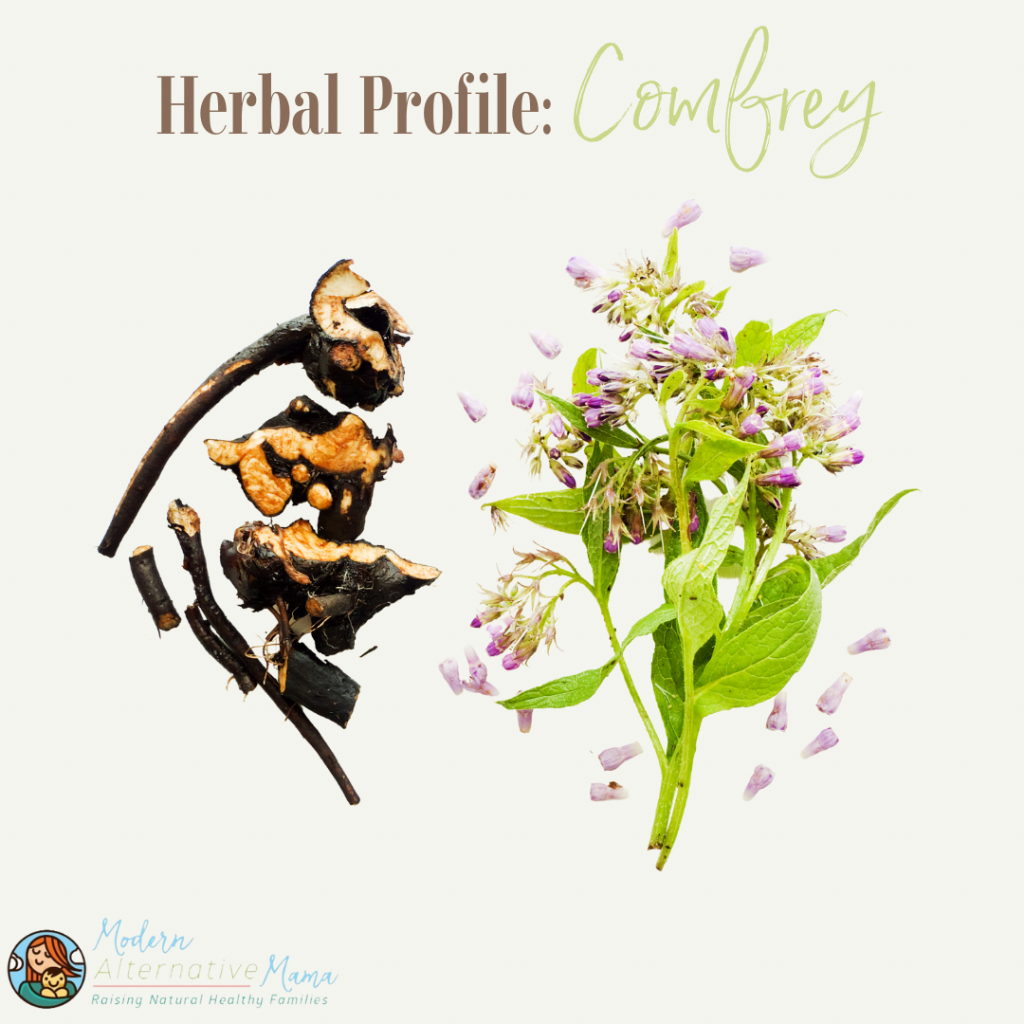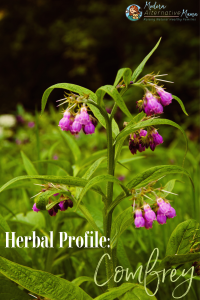What is Comfrey
Comfrey is sometimes called comfrey root, comfrey leaf, knitbone, boneset, bruisewort, or its scientific name Symphytum officinale. Comfrey is a wild flower, sometimes considered a weed from the Borage family, and grows slightly over 3 feet tall. Comfrey can be identified by its large, oval, hairy leaves and drooping, tubular pink flower clusters (1). Comfrey is native to Britain and extends throughout most of Europe into Central Asia and Western Siberia. Comfrey has been used for over 2,000 years to treat ailments like broken bones, sprains and rheumatism, liver problems, gastritis, ulcers, skin problems, joint pain and contusions, wounds, gout, hematomas, and thrombophlebitis (2,3).
Health Benefits of Comfrey
Comfrey is most commonly known for its pyrrolizidine alkaloids (PAs) content, which is considered toxic when ingested. Thankfully, comfrey has many other compounds like allantoin, rosmarinic acid, and tannins, all brimming with health benefits for topical application (4). Some amazing health benefits of comfrey include the following:
Antimicrobial Properties
An antimicrobial property is when a substance, or in this case, an herb, can kill or suppress the spread of microorganisms such as bacteria, viruses, protozoans, and fungi (5). Studies demonstrated comfrey extract’s potential antimicrobial effects on several bacterial strains tested, especially against Staphylococcus aureus (6). Comfrey’s antimicrobial properties largely come from its alkaloid compounds, which are brimming with broad-spectrum antimicrobial effects (7).
Antifungal Properties
An antifungal property is when a substance, or in this case, an herb, can fight the growth of specific pathogens that could harm your health, such as ringworm, athlete’s foot, tinea versicolor, toenail fungus, and jock itch (8). Studies have found comfrey leaves strongly inhibit fungi, such as the germination of Erysiphe graminis conidia and uredospores of Puccinia graminis (9).
Anti-Inflammatory Properties
Although inflammation is a natural bodily response, chronic inflammation can lead to detrimental health effects. Chronic inflammation has been linked with many diseases, such as type 2 diabetes, asthma, and certain cancers (10). Comfrey is widely known for its anti-inflammatory properties (11). Studies have found comfrey extract’s anti-inflammatory properties equal to or greater than diclofenac, a nonsteroidal anti-inflammatory drug (NSAID) (12,13).
Pain-Relieving Properties
As of 2016, an estimated 20.4% of U.S. adults (50.0 million) had chronic pain, and 8.0% of U.S. adults (19.6 million) had high-impact chronic pain (14). Studies have found the topical application of comfrey beneficial for many forms of pain, including muscle and joint pain and upper and lower back pain (15,16). Other studies have seen consistently promising results for arthritis pain when using topical comfrey without any adverse events (17,18,19).
Wound-Healing Properties
Due to comfrey’s antibacterial, antifungal, and anti-inflammatory properties, comfrey can provide exceptional wound-healing properties. Additionally, studies suggest comfrey’s allantoin compounds induce a wound-healing mechanism due to the regulation of inflammatory response and stimulus to fibroblastic proliferation and extracellular matrix synthesis (20). One study showed that comfrey could help heal abrasion wounds (21). Another study demonstrated topical application of comfrey cream led to a quicker regeneration of skin cells within 4–7 days (22).
Anti-Cancer Properties
Statistics say that 158.3 of every 100,000 individuals will die from cancer, but what if they didn’t have to (23)? Studies have found that poly[3-(3, 4-dihydroxyphenyl)glyceric acid] (p-DGA) from caucasian species of comfrey, Symphytum caucasicum is more effective compared to its synthetic derivative, syn -2, 3-dihydroxy-3-(3, 4-dihydroxyphenyl) propionic acid (m-DGA) against prostate cancer cells LNCaP and 22Rv1 (24).
Safety Concerns
The mainstream claims comfrey is possibly safe when used on unbroken skin in small amounts for less than six weeks. But the poisonous chemicals in comfrey can pass through the skin, so it is possibly unsafe to use comfrey on broken skin or to apply large amounts for more than six weeks. Additionally, the mainstream claims comfrey is likely unsafe when taken by mouth or applied to the skin while pregnant or breastfeeding. The pyrrolizidine alkaloids (PAs) in comfrey are absorbed through the skin and might cause congenital disabilities. They urge to avoid use during pregnancy and breastfeeding (25).
According to trusted herbalist Richard Whelan, external applications of comfrey leaf and root are no problem regarding potential toxicity and work beautifully. He states he uses a great deal of comfrey leaf and root in compresses and creams for a person with wounds or sores that are not healing well.
However, the internal use of comfrey has to be undertaken with great sensitivity and care, or not at all. Comfrey has real potential to harm the liver. Comfrey has performed further little miracles in my practice to this day. Still, Whelan uses it rarely and extremely carefully (doing frequent blood tests in my clinic while the patient uses it to look for characteristic hallmarks of liver stress). Richard would counsel anyone not trained in herbal medicine or who has undergone rigorous study into the scientific literature of comfrey to refrain from self-medicating with this plant internally.
Richard Whelan’s thoughts on when internal use is justified are well-represented here by the great English herbalist Thomas Bartram. He writes:
“It would appear that the use of the root of Symphytum officinale may be justified in the treatment of severe bone diseases for which it has achieved a measure of success in the past, such as rickets, Paget’s disease, fractured bones etc. its benefits outweighing risks. Few other medicinal plants replenish wasted bone cells with the speed of Comfrey.”
Richard Whelan goes on to say comfrey combines extremely well with calendula and plantain weed to help to heal. It will be much wiser for many people to use either of those great herbs for any internal ‘wounds’ and only add the comfrey if the treatment is used externally. Comfrey can also work particularly well with a little licorice or marshmallow root for cracks, cuts, and dry skin problems that are not healing well (26).
Additionally, there is no evidence or relevant published information on the negative effects of comfrey on lactation or breastfed infants (27). That said, I would be comfortable using comfrey topically while pregnant or breastfeeding.
How to Use Comfrey
You can find comfrey in dried bulk, pills, powders, teas, extracts, or tinctures. Tinctures always contain the most concentrated amount of herbs. Teas and soups are also options, especially when following ayurvedic medicine recipes. If you’re a DIY person, some great starter recipes are:
Follow the recommendations of any supplement; some of my recommendations include:
- Earthley’s Blueberry-Hemp Moisturizer relieves skin inflammation and stimulates pro-collagen production. Heal damaged skin, improve signs of premature aging, and naturally cool the face with nature’s power.
- Earthley’s Eye Serum smoothes wrinkles, nourishes delicate skin, and banishes dark circles under the eyes. Earthley infused a blend of oils (blueberry seed, rosehip seed, and prickly pear) with herbs (comfrey, calendula, ginger, licorice root) to improve circulation and reduce inflammation.
- Earthley’s Herbal Soothing Bath is the natural way to enjoy an at-home spa night. This floral soak is safe and beneficial to sensitive skin with no artificial fragrance or ingredients. Cleanliness and postpartum healing go hand-in-hand when you bathe with our organic bath tea. Soak away soreness, enjoy aromatherapy, and promote healing, all while relaxing.
- Earthley’s Sun Soothe is an all-natural, after-sun lotion to help calm skin overexposed to the sun. This cooling lotion helps to relieve pain and redness, prevent peeling, and moisturize the skin.








Under “can be used for”, it says “inflation”. I’m sure that should read “inflammation”. But if it truly can be used for inflation, I’m going to be planting it at my local gas stations, and I’ll send some to the White House! 🙂
I like this… Thanks
Hakan
I brought home a piece of comfrey from a friends’ home in Pennsylvania over 20 years ago. The original plant as well as several divisions still decorate the outside of my home. You can’t kill it! This is a good thing for me. I love the way it looks and the small purple/blue flowers. The best use for a large comfrey plant, however, was as a hideout for my Maine Coon cat, Rocky. He used to hide under the leaves and if anyone walked by he would pounce! He’s been gone for several years, now, but he still sits under (and I really mean under) the comfrey plants. I miss his pounces!
[…] Herbal Spotlight: Comfrey […]